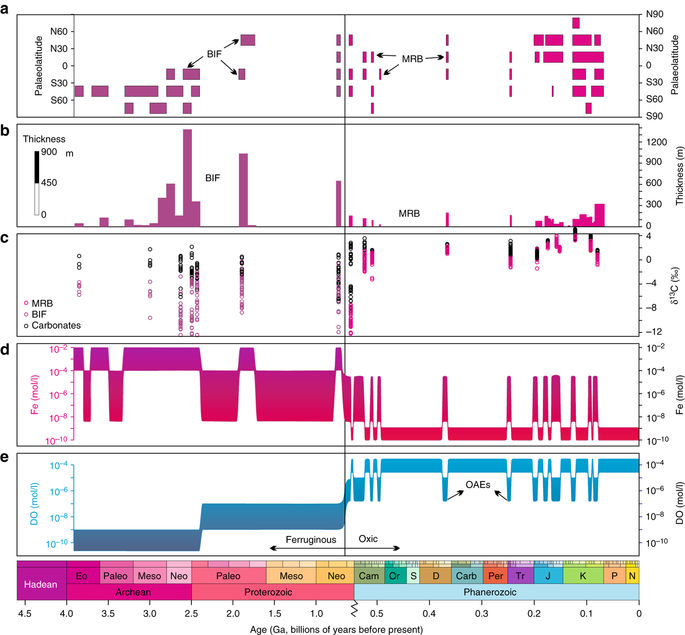Abstract
Banded iron formations were a prevalent feature of marine sedimentation ~3.8–1.8 billion years ago and they provide key evidence for ferruginous oceans. The disappearance of banded iron formations at ~1.8 billion years ago was traditionally taken as evidence for the demise of ferruginous oceans, but recent geochemical studies show that ferruginous conditions persisted throughout the later Precambrian, and were even a feature of Phanerozoic ocean anoxic events. Here, to reconcile these observations, we track the evolution of oceanic Fe-concentrations by considering the temporal record of banded iron formations and marine red beds. We find that marine red beds are a prominent feature of the sedimentary record since the middle Ediacaran (~580 million years ago). Geochemical analyses and thermodynamic modelling reveal that marine red beds formed when deep-ocean Fe-concentrations were > 4 nM. By contrast, banded iron formations formed when Fe-concentrations were much higher (> 50 μM). Thus, the first widespread development of marine red beds constrains the timing of deep-ocean oxygenation.

Secular distributions and carbon isotopes of Fe-related rocks and the evolution of marine redox and iron states. a Palaeolatitudinal distribution of banded iron formations (BIFs) and marine red beds (MRBs). The data are compiled from Supplementary Table 2. Note that the palaeolatitude data are at a lower confidence level for Archean and early Proterozoic interval. b Temporal distribution of BIFs and MRBs with thickness information (see data in Supplementary Figs. 1, 2 and Supplementary Table 2). c Carbon isotopes in iron-related sedimentary rocks and adjacent carbonates (purple circle are the data from banded iron formations, magenta circles are the data from red beds, black circles are the data from adjacent grey carbonates; see data in Fig. 3 and Supplementary Figs. 3–7 and Supplementary Tables 1, 3). d Evolution of deep-water (below storm wave base) iron concentrations based on numerical model (Fig. 4) and modern analogues. The lower limit of iron concentrations for BIF and MRB are 50 μM and 4 nM, respectively (see discussion in text). e Evolution of deep ocean (below storm wave base) redox states in the Phanerozoic and Precambrian (after refs 9, 57)
Title: The onset of widespread marine red beds and the evolution of ferruginous oceans
Authors: Song, H., Jiang, G., Poulton, S. W., Wignall, P. B., Tong, J., Song, H. Y., An, Z., Chu, D.,
Tian, L., She, Z., and Wang, C.
Source: Nature Communications, v. 8, no. 399
Published: 30 August 2017
DOI: 10.1038/s41467-41017-00502-x.
Link to the paper: https://www.nature.com/articles/s41467-017-00502-x